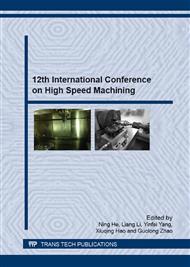p.263
p.270
p.277
p.283
p.290
p.296
p.304
p.310
p.318
Effect of Optimizing PID Parameters and Spindle Speeds on Processing Performance of KDP Micro-Defect Mitigation Machine Tool
Abstract:
PID parameters of machine tool for micro-defect mitigation of KDP crystal had been optimized, after which the velocity fluctuation frequency and amplitude variation of motion axis under different spindle speeds were studied. It is evident that the stability and following errors of the system run better under the velocity&acceleration feed forward PID control algorithm and Notch filters. The velocity fluctuation frequency of motion axis varies with spindle speeds significantly when the tool system is stable, while the fluctuation amplitude variation is slightly changed. To be conclude, the optimal working spindle speed is verified to be 4.78×104 rpm based on comparative experiments, at which damage pits can be mitigated by micro-machining successfully with roughness value of 34.4nm.
Info:
Periodical:
Pages:
290-295
Citation:
Online since:
January 2016
Authors:
Keywords:
Price:
Сopyright:
© 2016 Trans Tech Publications Ltd. All Rights Reserved
Share:
Citation:


